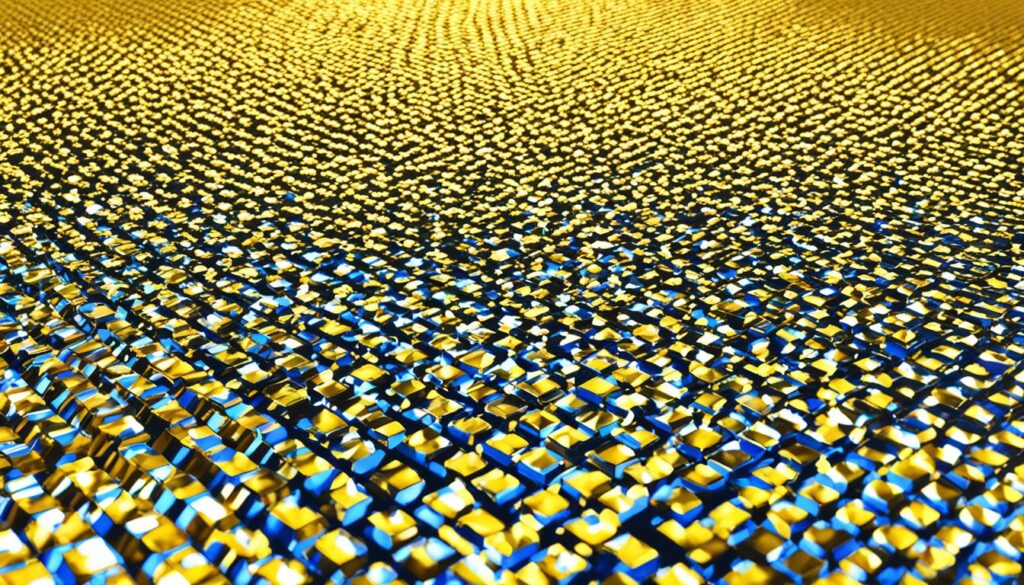EPFL researchers have made a huge leap in solar technology. They found quantum effects in gold films that change how light is used. This breakthrough could make solar cells more efficient and help in creating eco-friendly energy sources.
At the École Polytechnique Fédérale de Lausanne, scientists introduced a new model. It explains how thin gold films behave on a quantum level. This isn’t just a win for science; it’s a giant leap for solar technology worldwide.
Understanding the Quantum Effects in Gold Films
The quest to uncover quantum behavior in gold films marks a thrilling chapter in materials science. EPFL’s team is leading this charge. They focus on the optical properties of gold, showing immense passion and precision. These thin films, sometimes just nanometers across, glow when hit by light due to quantum effects. This not only fascinates but also lights the path to better solar energy harvesting.
To appreciate this work, one must see beyond classical physics. This research enters the quantum realm, challenging old rules. EPFL uses quantum modeling techniques based on real experiments. These methods reveal how gold reacts to light at a very detailed level, setting the stage for breakthroughs in technology.
EPFL’s findings have practical aims beyond theory. By studying quantum behavior in gold films, they aim to revolutionize solar cells. These films’ optical traits are key to this, making them absorb and convert light better. This shows the strong link between quantum physics and materials science, thanks to EPFL’s research.
EPFL also values research ethics and the sharing of knowledge. As they explore quantum properties, they maintain these principles. This approach ensures that future tech derived from their research is used widely and for the common good. Their commitment to ethics enhances their work’s value and envisions a future of efficient, ethical solar energy use.
The Impact of Surface Plasmon Resonance on Solar Technologies
The study of surface plasmon resonance (SPR) in gold nanoparticles is starting a new chapter for solar energy, expanding what’s possible with thin film technology. SPR is at the heart of this leap forward, offering a way to greatly improve how photovoltaic cells work. When light hits the electrons on the gold nanoparticles, it causes collective vibrations. This phenomenon significantly boosts light absorption and raises energy conversion rates.
Investigating these gold-coated films reveals a clear path to better solar cell performance, thanks to SPR. Being able to control this resonance affects how well solar cells convert light into power. This includes how much light they can absorb and how much electric current they generate. Scientists adjust the gold nanoparticles’ size and shape to change the SPR peak. This lets them customize the films for specific types of light, using advanced thin film technology.
The partnership between gold nanoparticles and thin film technology is shaping the future of solar energy. It leads to materials that are not only more efficient but also durable and cost-effective. As we explore and use these innovations, surface plasmon resonance will play a key role in advancing solar technologies worldwide.

Quantum Effects in Gold Films: Paving the Way for Next-Gen Solar Cells
The quest for advanced solar cell technology is taking a huge leap. This is thanks to researchers at EPFL who are exploring quantum effects in gold films. They’re discovering ways to revolutionize solar energy collection and conversion. These discoveries could majorly impact renewable energy progress.

Exploring these quantum effects is not just about making solar cells work better. It’s also about giving them new abilities. Using quantum mechanics, scientists can control light and energy very precisely. This could let advanced solar cell technology capture more sunlight and use energy more efficiently. Such advancements could greatly improve how solar power is used.
EPFL’s research into quantum effects in gold films application keeps them at the forefront of sustainable energy. Their innovative work might change how solar cells are made. They aim to create models that are not only more efficient but also better for the planet. This could help in the fight against climate change and the move towards cleaner energy.
This advanced solar cell technology at EPFL could be a game changer. As we face climate change and fossil fuel issues, this technology could greatly help. It represents a blend of quantum science and real-world energy solutions. Such innovation could define the future of technology and how we care for our planet.
EPFL’s Pioneering Quantum Modeling Techniques and Innovations
At the heart of EPFL’s research is a big leap in quantum modeling. This leap is shaping the future of solar cell tech. EPFL’s experts are working hard to understand the quantum realms. These realms control materials like thin gold films. This work is key to advancing our solar technology.

EPFL’s focus is on how tiny atomic interactions affect solar cells. They use advanced computation and simulation to explore these interactions. This is how they are making solar cells more efficient and effective. EPFL combines theory and experiments in a powerful way. This approach has made it a leader in innovation.
EPFL’s research is changing the solar cell field. Each discovery in modeling opens new doors in advanced manufacturing. This could change how we use the sun’s energy.
Future of Solar Energy: From Quantum Behavior to Commercialization
The future of solar energy is changing fast, all thanks to advances in technology. Researchers at EPFL have discovered how quantum effects in thin gold films can boost solar cells. This breakthrough could completely change how we design solar panels. With EPFL leading the way, we’re getting closer to making these advanced solar panels a reality. They could make solar energy more efficient and sustainable than ever before.
Before these new panels hit the market, they must be carefully tested and proven effective. EPFL is leading these efforts, aiming to meet our energy needs with clean, renewable power. They’re focused on making solar energy economical. This means creating solar panels that not only help the planet but are also cost-effective. This approach will help more people switch to solar energy, benefiting both the environment and the economy.
EPFL’s work is a team effort. They’re committed to innovation and partnering with others to make quantum-enhanced solar panels practical for everyday use. This new technology promises to make solar power more efficient and affordable. With EPFL’s ongoing research, the promise of a greener, more sustainable future is within reach. Their work shows how forward-thinking research can lead to real-world solutions that help us turn to renewable energy sources.
